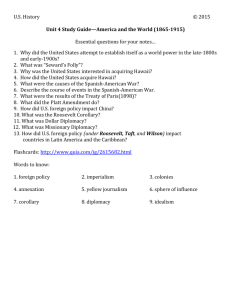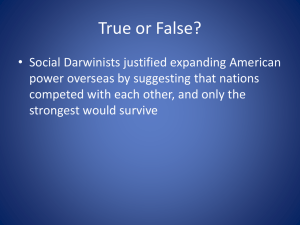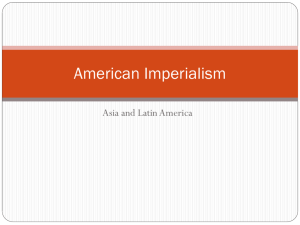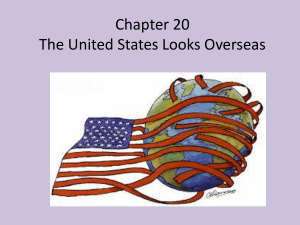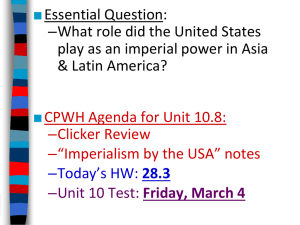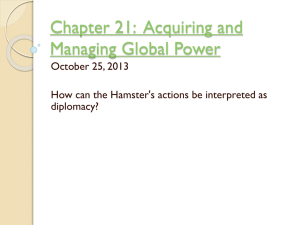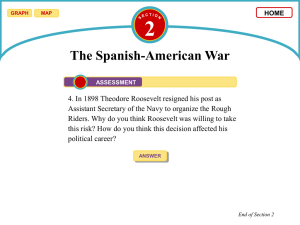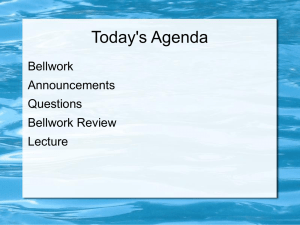Chapter 23 Study Guide
advertisement
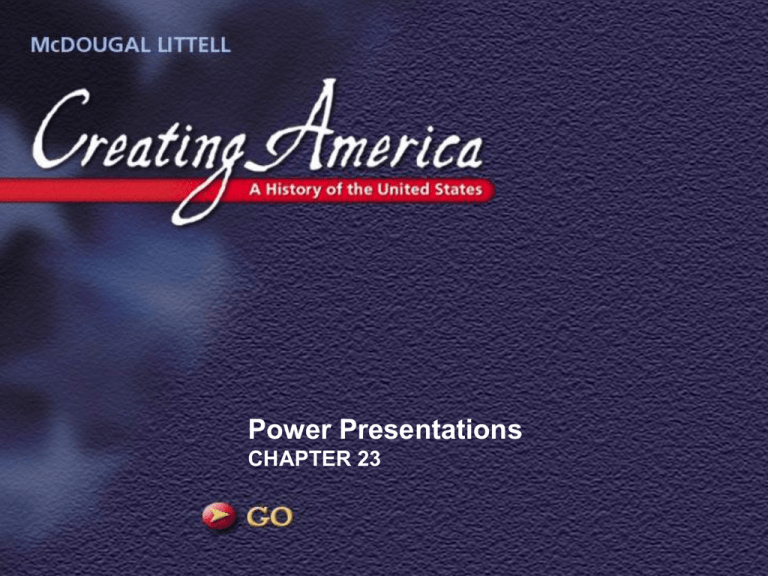
Power Presentations CHAPTER 23 Expansion Image In 1893, American sugar planters in the kingdom of Hawaii think that they could make more money if Hawaii were an American state. So they stage a revolt and take control of the government. Now they want you, the U.S. president, to take control of Hawaii. When should you get involved in the affairs of another country? • What interests does the United States have in other countries? • How important is protecting those interests? • How important are the opinions of another country’s citizens? 1887 Hawaii grants United States exclusive use of Pearl Harbor. 1892 Grover Cleveland is elected president. 1893 Planters overthrow the Hawaiian queen, Liliuokalani. 1896 William McKinley is elected president. 1898 Spanish-American War takes place. 1901 Theodore Roosevelt becomes president after McKinley is assassinated. 1904 Roosevelt is elected president. 1908 William Howard Taft is elected president. To World 1912 Woodrow Wilson is elected president. 1914 Panama Canal opens. Image 1885 European nations divide Central and West Africa at the Berlin West Africa Conference. 1895 Sino-Japanese War ends with Japanese victory over China. 1900 Boxer Rebellion occurs in China. 1903 Republic of Panama established. 1904 Russo-Japanese War begins. 1910 Mexican Revolution begins. 1916 Pancho Villa makes a raid in the United States. Back to U.S. Back to Home Main Idea The United States expanded its interest in world affairs and acquired new territories. Why It Matters Now During this period, the United States acquired Alaska and Hawaii as territories. What were the causes of U.S. expansion overseas in the late 1800s? CAUSES EFFECT Economic leaders sought markets and raw materials. Political leaders wanted to establish a military presence overseas. Americans’ belief in the superiority of culture also their fueled expansion. UNITED STATES EXPANSION • Where was the focus of U.S. expansion before the late 1800s? Map • How did William Seward contribute to U.S. expansion? • Why did the American planters’ request for the annexation of Hawaii fail in the early 1890s? Making Inferences What benefits were American planters looking for when they staged a revolt in 1893? Think About • the new policies of Queen Liliuokalani • changes in U.S. trade laws Back to Home Main Idea Independence movements in Spanish colonies led to the Spanish-American War in 1898. Why It Matters Now U.S. involvement in Latin America and Asia expanded greatly after the Spanish-American War. What were the major events of the Spanish-American War? SPANISH-AMERICAN WAR, 1898 April The explosion of the Maine leads to a declaration of war. July American troops take San Juan Hill, and Puerto Rico falls to the United States. May Dewey destroys Spanish fleet in Manila Bay. August Spain signs truce. Image December Final peace treaty is signed in Paris. • What led to the Cuban rebellion against Spain in 1895? • What was the first major military event of the Spanish-American War? • What happened in the Philippines after the war? Forming Opinions Did the United States betray its democratic principles when it made the Philippines a colony? Think About • the public’s response to yellow journalists and U.S. military victories • the work of the Anti-Imperialist League Back to Home Main Idea In the early 1900s, the United States expanded its involvement in Asia and Latin America. Why It Matters Now The United States still trades extensively with Asian and Latin American countries. Record details about U.S. involvement in Asia and Latin America? ASIA LATIN AMERICA • Filipino independence movement defeated • Panama Canal • U.S. economic interests in China • Open Door Policy • U.S. economic interests in the region • Roosevelt Corollary • Why was the United States interested in the Philippines? • Why was the nation of Panama created in 1903? • How did the Roosevelt Corollary change U.S. foreign policy? Map Drawing Conclusions Why did the United States become so heavily involved in Asia and Latin America? Think About • U.S. economic growth • American military interests Back to Home REVIEW QUESTIONS ANSWERS: READ AND TAKE NOTES 1 Why did Americans become interested in overseas expansion in the late 1800s? 2 How did the public react when William Seward negotiated the purchase of Alaska in 1867? 3 Why did the United States take an interest in Hawaii? 4 Why might President Cleveland have wanted to restore Queen Liliuokalani to the Hawaiian throne? 5 How did the Spanish-American War begin? 6 What were the most important battles of the war? 7 What territory did the United States take control of as a result of its victory over the Spanish? 8 Why did U.S. leaders want access to China’s markets after the Spanish-American War? 9 Why was there an interest in building a canal across Latin America? 10 How were the Latin American policies of Roosevelt, Taft, and Wilson similar? Finding Main Ideas REASONS FOR U.S. EXPANSION OVERSEAS Philippines give potential access to Chinese markets. U.S. companies take advantage of cheap raw materials in Latin America. Hawaii is used as refueling stop for ships bound for Asia. Spanish-American War highlights need for Panama Canal. Christian missionaries move to Hawaii to convert local population. Boxer Rebellion is a reaction against foreign treatment of Chinese. Back to Home These labels let you know where you are in the presentation. When you click on the arrow you will be linked to a related visual. Map Image These buttons link you to special areas. Use these buttons to go back to the previous slide, or to move forward in the presentation. To reveal the content of a slide just press the space bar or click your mouse once. To use a button, move your pointer over the button. When your pointer becomes a hand, click your mouse. Back to Previous
